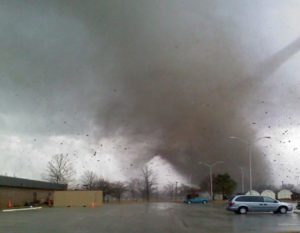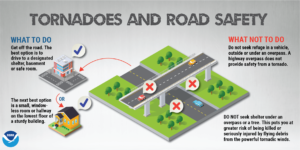By Melissa Buckley, Fort Leonard Wood Public Affairs Office
FORT LEONARD WOOD, Mo. (March 13, 2023) — It is one of those sounds nobody ever wants to hear — the piercing roar of echoing tornado sirens followed by a giant voice urging listeners to shelter in place — but knowing what to do when the sound is activated can save a life. For that reason, Fort Leonard Wood participated in Missouri and Kansas Severe Weather Preparedness Week by having an installation wide tornado drill on Tuesday.
“Tornado season is generally early spring through late summer, although we are at risk of tornados year-round,” said Craig Reeves, with the Fort Leonard Wood Garrison Safety Office. He was referring to a tornado that damaged several structures here on New Year’s Eve 2010.
“It’s always good to have drills, so we become more knowledgeable and form habits to protect ourselves. Doing this at the beginning of the tornado season is always a good idea,” Reeves said.
According to Robb Hylton, a mobilization officer with the Directorate of Public Works’ Planning Division, drills like the one on Tuesday are essential because practice really does make perfect.
“Fort Leonard Wood’s participation in tornado drills is integral to the safety and survival of residents. The drill allows personnel to adjust plans if needed and determine if the shelter is large enough for all employees,” Hylton said.
Matthew Mertz, Fort Leonard Wood’s Installation Emergency manager, agreed.
“Drills prepare people to know what appropriate actions to take and where to seek shelter. Tornado drills allow supervisors to determine whether their plan is executable, effective and if their employees know and understand the plan,” Mertz said.
Just like in an actual emergency, 100 percent accountability was taken of the post’s service members and Department of Defense personnel immediately following the drill.
“Accountability allows supervisors to ensure their employees are safe from immediate danger, understand what further actions to take to stay safe, and determine if an employee is injured or in need of assistance,” Mertz said. “Accountability can be very difficult during a weather emergency. Accurate contact rosters and telephone trees can make accountability easier and faster.”
According to Reeves, any time severe storms are developing, people should be weather aware, and that starts with knowing the difference between a tornado watch and tornado warning.
“A tornado watch means conditions are favorable for tornados to develop. A tornado warning means there has been confirmation of a tornado, by either someone on the ground or by radar,” Reeves said.
According to the National Weather Service a tornado warning indicates imminent danger to life and property.
Reeves stressed the first thing to do when a tornado warning has been issued is move to a safe area.
“Federal Emergency Management Agency shelters are always the best, but if you lack that option, small interior rooms away from the southwest portion of the building is a good option, as well,” Reeves said. “A room that gives you more structural protection is a good option. Underground areas such as basements are a very good option as well. Stay away from exterior walls.”
Hylton pointed out Fort Leonard Wood has three designated severe weather shelters — Bldg. 14000’s Hoge Hall, General Leonard Wood Army Community Hospital and Bldg. 1000, the Military Police Station.
Reeves said trying to ride out or outrun a tornado in a vehicle is a bad idea. Reeves knows firsthand just how scary it can be.
“I have been in a tornado that literally dropped out of the sky on me while I was driving,” he said. “One second it was light rain, I was driving down I-44. The next second I am in the middle of a small tornado and could do nothing but slow down and try to keep the vehicle on the road.”
Reeves didn’t get a warning but said anyone in a car who hears sirens or believes a tornado is nearby should get out of that car immediately.
“Find cover, into as low of an area as you can find — a ditch or culvert is a good location,” Reeves said.
According to Mertz, during a tornado people face hazards from extremely high winds and risk being struck by flying and falling objects. He reminded the community that the violently rotating storm is not the only dangerous part of the weather event.
“After a tornado, the damage left behind poses additional injury risks, too,” Mertz said.
The Fort Leonard Wood community uses the ALERT! mass notification system. Service members and DOD civilians are automatically enrolled to receive notifications, but family members must sign up. Call 573.563.5606 or visit the Fort Leonard Wood website for more information.
For information on preparing emergency supplies and planning for the safety of pets, visit the Department of Homeland Security’s Ready website.



